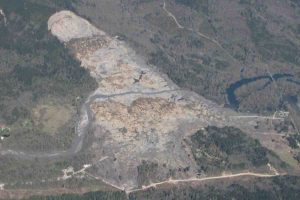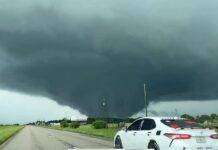
Washington State University researchers say landslides on logged forests will be more widespread as the Northwest climate changes.
In a study modelled on clear-cut lands on the Olympic Peninsula, they anticipate the climate of 2045 and conclude that there will be a 7 -11 percent increase in the land that is highly vulnerable to landslides. The researchers say their findings are applicable to the Cascade Mountain Range area as well.
The study, published in Engineering Geology, is the first to look at landslides and climate change in the Pacific Northwest. The University of Washington’s Climate Impacts Group “State of Knowledge” report in 2015 looked at reasons behind climate-influenced landslides — earlier snowmelt, more rain, less cohesive soils — but stopped short of predicting an increase in landslides.
The WSU study goes a step further.
“Logged landscapes become more susceptible to landslide activity under climate change,” said Jennifer Adam, an associate professor of civil and environmental engineering and associate director of the State of Washington Water Research Center.
Warning and tool
Adam said the study can serve as both a warning and a tool, helping land managers identify several features of vulnerable slopes that can guide their harvesting decisions. The researchers found vulnerable slopes tend to be at elevations over 1,600 feet, with slopes in the range of 40 or more degrees and talus or sandy soils.
“This study allowed us to look at exactly what characteristics of the landscape became more susceptible, allowing us to identify win-win situations in which both environmental and economic outcomes can be improved by targeted logging locations,” Adam said. “It’s not that we’re saying, (Would it be clearer to say, “We’re not saying, ‘Don’t log….”)
‘Don’t log because you’re going to have more landslides.'”
The study, said lead author Muhammad Barik, “is telling people, if you are cutting trees on this slope, it might be OK today. But in the future, it might not be, so plan according to that. If you do logging in this area without considering future projections, it might become susceptible to landslides.”
Oso landslide
Washington witnessed the deadliest landslide in U.S. history three years ago when 270 million cubic feet of mud barreled through a neighborhood outside Oso, Wash., killing 43 people and destroying 49 homes. A subsequent engineering report found that recent logging may have increased the amount of water on the slope, though the report did not pin the slide on any single cause.
Landslides also can lead to billions of dollars of economic losses and damage aquatic habitats, including those used by the region’s endangered salmon, the researchers write. Clear-cutting reduces the rainfall that can be intercepted by leaves and reduces the ability of roots to reinforce soil that is more likely to be saturated under the Northwest’s changing climate.
“Wet soil is not cohesive, so it becomes very unstable,” said Adam. “If you don’t have a lot of vegetation and deep roots holding that soil in place, then it becomes susceptible to landslides.”
Olympic Forest
Adam and Barik looked at one of the wettest locations in the continental United States, the Queets watershed in the Olympic Experimental State Forest, which receives between 96 and 236 inches of rain a year. While they chose the area for its varied geography, it is typical of rainforest from southern Oregon to southeast Alaska. Their hydrologic model, which is commonly used around the Pacific Northwest, considered variations in soil, land cover, topography and subsurface moisture as it simulated water-induced slope failures. They factored in meteorological data, a digital landslide database and satellite imagery.
Climate change is expected to bring warmer and wetter winters to the region, as well as more frequent extreme rainfall events.
“The combination of warming, precipitation and less snow means more liquid precipitation, which will then sit in the soil and keep it wet and unstable,” said Adam.
To anticipate the climate of 2045, the researchers used two greenhouse-gas emission scenarios of the United Nations’ Intergovernmental Panel on Climate Change. One scenario, which predicts the lowest emissions, saw an average 7.1 percent increase in the area highly susceptible to landslides. The other scenario, which predicts the highest emissions, saw an average increase of 10.7 percent.
“We’re giving you a tool to see into the future,” said Barik, who did the research as part of his WSU doctoral studies. “Most of the landslide studies are based on historical data. Here, along with historical data, we also used climate models so you can look at future projections.”
Reference:
Improved landslide susceptibility prediction for sustainable forest management in an altered climate. DOI: 10.1016/j.enggeo.2017.09.026
Note: The above post is reprinted from materials provided by Washington State University.










